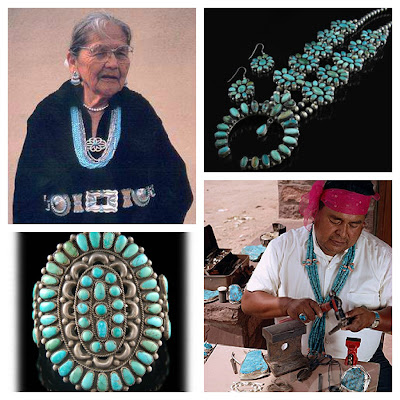Turquoise tour...
With the post on turquoise, I was just too enamored of all the applications, cultures, time periods... that have loved and used this stone. I wanted to share a little of this history with you, without putting on my Art History geek hat. So - images and a few words. Maybe they will whet your appetite to read more! Enjoy!
 |
| Serpent pectoral, 3 mosaic skulls. |
 Ancient Egypt - I think most of us are familiar with the iconic look, the distinct aesthetic of Ancient Egyptian art and jewelry. Jewelry was worn by both sexes and all levels of society. It was often talismanic in nature, and represented symbols associated with gods and goddesses from the Egyptian pantheon.For example: The Egyptian Scarab Beetle was used as an amulet or a good luck charm by both the rich and the poor. A depiction of a scarab beetle was used in the making of jewelry in the form of various types of pendants, bracelets, rings and necklaces. Scarab jewelry was believed to hold strong magical and religious properties and the Scarab was a symbol of rebirth. (Gem Select) What isnt as well known is the strong associations/symbolic meanings that colors held. Lapis represented royalty. Turquoise - the tropical sea - stood for joy, cleanliness, pleasure.
Ancient Egypt - I think most of us are familiar with the iconic look, the distinct aesthetic of Ancient Egyptian art and jewelry. Jewelry was worn by both sexes and all levels of society. It was often talismanic in nature, and represented symbols associated with gods and goddesses from the Egyptian pantheon.For example: The Egyptian Scarab Beetle was used as an amulet or a good luck charm by both the rich and the poor. A depiction of a scarab beetle was used in the making of jewelry in the form of various types of pendants, bracelets, rings and necklaces. Scarab jewelry was believed to hold strong magical and religious properties and the Scarab was a symbol of rebirth. (Gem Select) What isnt as well known is the strong associations/symbolic meanings that colors held. Lapis represented royalty. Turquoise - the tropical sea - stood for joy, cleanliness, pleasure.
Turquoise was so desired by all classes, the first fakes were created. Egyptain faience is a blue self glazing pottery paste - that simulated the look of turquoise!
 |
| From top left: Faience ushabti, Faience hippo, scarab pectoral, netted collar necklace. |
 Navajo: Silversmithing is an important art form among Navajo. Atsidi Sani (ca. 1830–ca. 1918) is considered to be the first Navajo silversmith. He learned silversmithing from a Mexican man called Nakai Tsosi ("Thin Mexican") around 1878 and began teaching other Navajos how to work with silver. By 1880, Navajo silversmiths were creating handmade jewelry including bracelets, tobacco flasks, necklaces and bracers. Later, they added silver earrings, buckles, bolos, hair ornaments, pins and squash blossom necklaces for tribal use, and to sell to tourists as a way to supplement their income.
Navajo: Silversmithing is an important art form among Navajo. Atsidi Sani (ca. 1830–ca. 1918) is considered to be the first Navajo silversmith. He learned silversmithing from a Mexican man called Nakai Tsosi ("Thin Mexican") around 1878 and began teaching other Navajos how to work with silver. By 1880, Navajo silversmiths were creating handmade jewelry including bracelets, tobacco flasks, necklaces and bracers. Later, they added silver earrings, buckles, bolos, hair ornaments, pins and squash blossom necklaces for tribal use, and to sell to tourists as a way to supplement their income.Heishe necklaces have been made by several southwest tribes since ancient times. The word "heishe" comes from the Santo Domingo word for "shell." A single heishe is a rolled bead of shell, turquoise, or coral, which is cut very thin. Shells used for heishe included mother-of-pearl, spiny oyster, abalone, coral, conch and clam. Tiny, thin heishe was strung together by the Santo Domingo to create necklaces, which were important trade items.
Silversmiths dominate the production of jewelry centered in the Four Corners region of the American Southwest. Early in the 1800s, Spanish and, later, Mexican, silver buttons, bridles, etc. became available in what is now Arizona, Colorado, New Mexico and, Utah through acquisition and trade. Navajo (Diné) artists began working silver in the 1850s after learning the art from Mexican smiths. The Zuni, who admired the silver jewelry made by Navajo smiths, traded livestock for instruction in working silver. By 1890, Zuni smiths had instructed the Hopi as well.
The centuries old art of lapidary, preserved by clan and family tradition, remains an important element of design. Stone on stone mosaic inlay, channel inlay, cluster work, petite point, needle point, and natural cut or smoothed and polished cabochons fashioned from shells, coral, semi-precious and precious gems commonly decorate these works of art with blue or green turquoise being the most common and recognizable material used. ( Overview from WIki)
 |
| bracelet, inlay roadrunner pin, turquoise bear fetish, Onyx Zuni bear fetish, inlay Hopi kachina. |
Thanks for stopping by!
Jenny


OHHHH. I cannot wait to read this! Egats! Time - I need you!!!
ReplyDelete